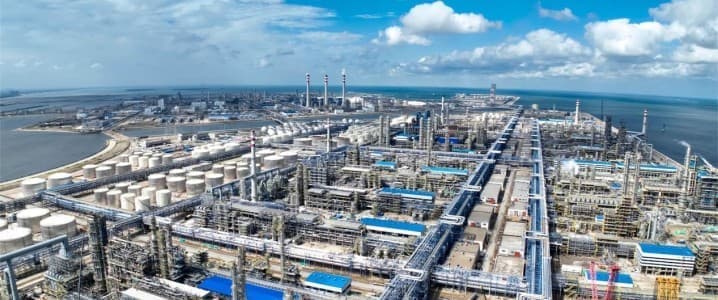Copyright OilPrice

Donald Trump’s U.S. Presidency 2.0 differs in one great respect from the 1.0 beta version. The aim is the same – to cement his country as the leading superpower on the planet – but the approach in dealing with America’s rivals has a sharper edge. Nowhere has this been more clearly seen than in his administration’s dealings with the self-appointed leader of the alternative new world order, China. The imposition of further sanctions on more of Beijing’s key mechanisms for effectively continuing to bankroll Iran and Russia is a case in point, and more of the same is expected to follow. In his first presidency, Trump was often criticised – even by those closest to him – as being soft on Beijing. The most serious of these accusations was stated by Trump’s former National Security Adviser, John Bolton, that the then-President “[gave up] security considerations for trade”. An early notable case in point had been the almost complete reversal of hard-hitting U.S. sanctions imposed on Chinese telecommunications company ZTE for committing major and repeated violations of the U.S. sanctions on Iran and North Korea. According to Bolton, after a private telephone call to President Xi – in which it transpired that Xi told Trump that he would “owe [Trump] a favour” if he reduced the sanctions against ZTE – Trump did exactly what Xi had asked for. Shortly after doing this, Trump tweeted: “President Xi of China and I are working together to give massive Chinese phone company, ZTE, a way to get back into business, fast. Too many jobs in China lost. Commerce Department has been instructed to get it done!” As Bolton put it in his book on the first Trump Presidency: “Since when had we started to worry about jobs in China?” Related: Kurdistan’s Oil Exports Top 200,000 Bpd amid Fragile New Deal However, as sources close to that first administration exclusively indicated to OilPrice.com at the time and subsequently, this approach was more a measure of the relative political naivety of the administration at the time than anything else. “Trump was used to dealing with rivals in a certain way based on his real estate background and elements of that carried into the first presidency,” said one such Washington-based source. “But he [Trump] saw that this method didn’t achieve the objectives he wanted, so they have changed this time around,” he added. “So now, he is still willing to play pally when he thinks it is beneficial to getting what he wants, but the flipside is a no-[BS] response,” he underlined. This was most palpably evidenced recently with the U.S.’s military support for wide-ranging Israeli strikes against Iran’s nuclear programme targets after his 60-day deadline to Iran to reach a new nuclear agreement. Before that, President-Elect Trump was key to pushing for the use of the critical operational elements that saw the removal of Bashar al-Assad from Syria in December – a regime that had been a particular irritant to him in his first term. He did this despite his apparently ‘friendly relationship’ with Russian President Vladimir Putin, with a key aim also being: “To put Moscow’s, Beijing’s and Tehran’s leadership on notice that Washington can easily redraw and restructure borders and regimes in not just the Middle East but also in Eastern Europe and elsewhere, if it wants to,” a senior source connected to the European Union’s security complex exclusively told OilPrice.com at the time. Similarly this time around, Trump is taking a much tougher approach to China’s Xi Jinping. Not only was Beijing at the receiving end of the highest tariffs anywhere in the first round of U.S. tariffs in April, but – having negotiated reductions down on both sides – Trump then reimposed them following China’s 9 October tightening of export controls on rare earth metals. Beijing additionally barred exports of rare earths for foreign military use, which directly affects U.S. defence supply chains. The timing looks like a geopolitical test of Trump personally by counterpart Xi, coming as it does ahead of the planned Trump–Xi summit in South Korea expected to take place on 30 October. In response, Trump ordered sweeping 100% tariffs on all Chinese imports starting 1 November, with a separate 130% tariff on select categories, aimed at high-tech and industrial goods. The same day as China’s tightening of export controls on rare earth metals, the U.S. Treasury Department also sanctioned China’s Rizhao Shihua Crude Oil Terminal at Lanshan port and Shandong Jincheng Petrochemical Group (an independent refinery in Shandong province), that have handled millions of barrels of Iranian petroleum. Treasury Secretary Scott Bessent accurately highlighted in a statement that: “The Treasury Department is degrading Iran’s cash flow by dismantling key elements of Iran’s energy export machine.” He added that the sanctions are aimed at entities that have: “Collectively enabled the export of billions of dollars’ worth of petroleum and petroleum products, providing critical revenue to the Iranian regime.” Indeed, China has been the key financial enabler of the current regime in Iran for years, and crucially as well from the U.S. perspective is doing the same for Russia, effectively prolonging the war in Ukraine. For Iranian oil, these massive ongoing exports to China are done on the extremely favourable terms for Beijing that are part of the all-encompassing ‘Iran-China 25-Year Comprehensive Cooperation Agreement’, as first revealed anywhere in the world in my 3 September 2019 article on the subject and analysed in full in my latest book on the new global oil market order. Specifically, China is allowed first refusal on most of the oil, gas, and petrochemicals projects that came up in Iran for the duration of the deal. Additionally, the per-barrel payments to China are the higher of either the mean average of the 18-month spot price for crude oil produced or the past six months’ mean average price, tilting the remuneration firmly in Beijing’s favour. The deal’s terms also include at least a 10% discount to China on the value of the oil it recovers – although in several cases with extra bonuses applied this totalled 30%. The latter is at the same discount to the lowest mean one-year average market price at the key gas pricing hubs for the gas that Chinese firms captured as well. The exact size of Beijing’s ongoing imports of oil from Iran is unknown for three key reasons. First, Iranian oil that does not officially go through China’s General Administration of Customs (GAC) is not entered into the country’s customs data and thus does not show up at all. Therefore, many millions of barrels of oil each month are imported to China in such a fashion and are then simply moved to the refineries where they are required or stored on land or at sea, effectively as part of China’s Strategic Petroleum Reserve, without ever having been recorded by the GAC. Consequently, to all intents and purposes, they do not exist as far as official figures are concerned. Second, the oil that arrives in China may well have been registered as being from Iraq in the first place, as it shares many major oil reservoirs with Iran, and it is largely impossible to tell from which side the oil has been extracted. Iran’s own former Petroleum Minister, Bijan Zanganeh, publicly highlighted how this is done in 2020. He said: “What we export is not under Iran’s name -- the documents are changed over and over, as well as [the] specifications.” And third, as an extra fail-safe against tracking, Iranian oil designed for China is often transferred from ship to ship at sea – in non-Chinese territorial waters (Malaysian and Indonesian waters are especially popular in this regard). As Iran’s former Foreign Minister, Mohammad Zarif, stated in December 2018 at the Doha Forum: “If there is an art that we have perfected in Iran, [that] we can teach to others for a price, it is the art of evading sanctions.” This latest U.S. escalation against China follows a gradual ramping up of pressure by Washington on Beijing for its ongoing support of Iran and Russia. Just before the latest sanctions, the U.S. State Department had imposed further prohibitions on 20 entities it believed were engaged in trading Iranian oil and petrochemical products, including China’s Zhoushan Jinrun Petroleum Transfer Co., an oil terminal in the greater Zhoushan port area. In an extremely similar tone and wording to Brian E. Nelson’s comments on sanctions imposed on Hong Kong entities in 2023, the Department said: “The Iranian regime continues to fuel conflict in the Middle East to fund its destabilizing activities, [and] Today, the United States is taking action to stem the flow of revenue that the regime uses to support terrorism abroad, as well as to oppress its own people.” Zhoushan Jinrun was the fourth of China’s ports to be sanctioned by Washington in recent weeks, following similar actions against Huaying Huizhou Daya Bay Petrochemical Terminal Storage in March, Guangsha Zhoushan in April, and Dongying Port in May. By Simon Watkins for Oilprice.com More Top Reads From Oilprice.com: SLB Exceeds Profit Expectations on Strong North American Demand India Rejects U.S. Claims of Halving Russian Oil Imports Citi Makes a Case for $50 Oil



